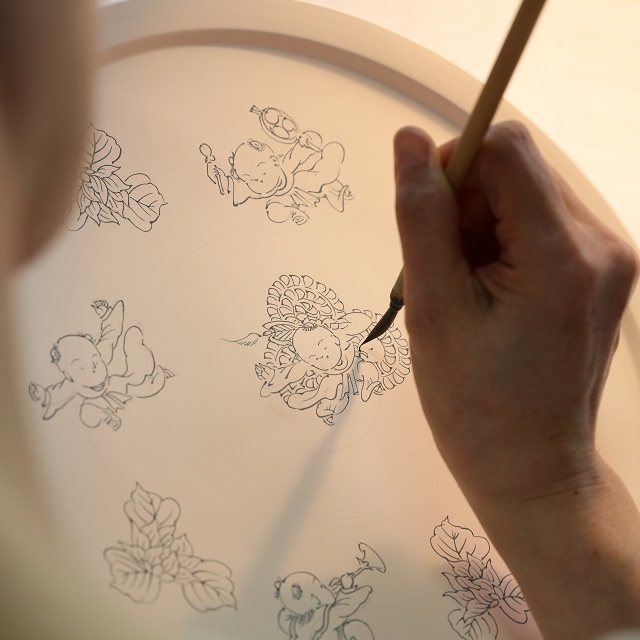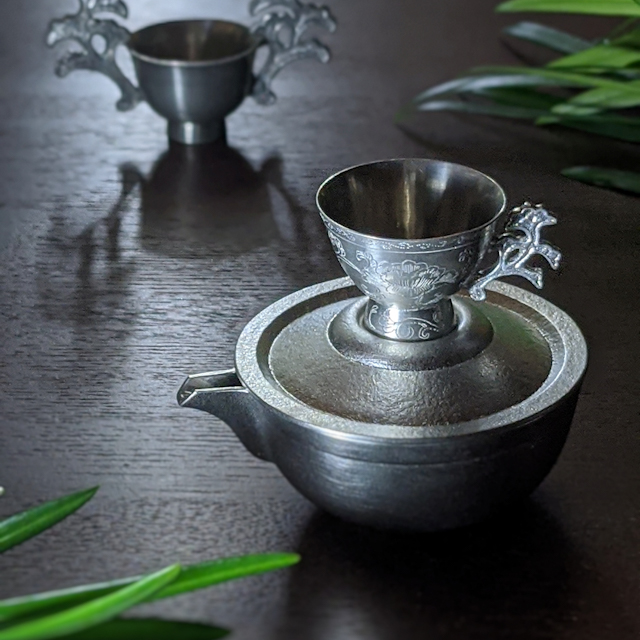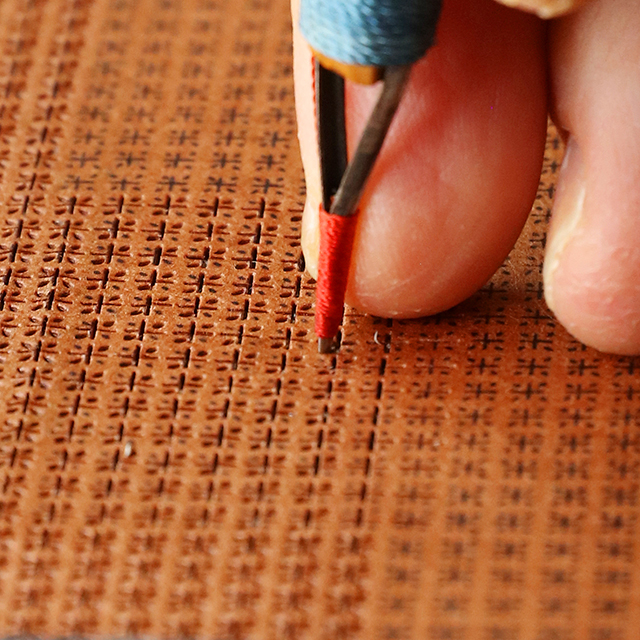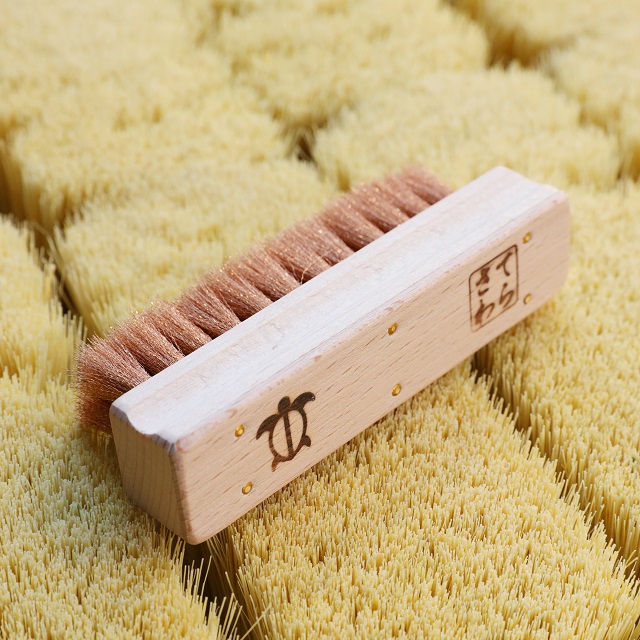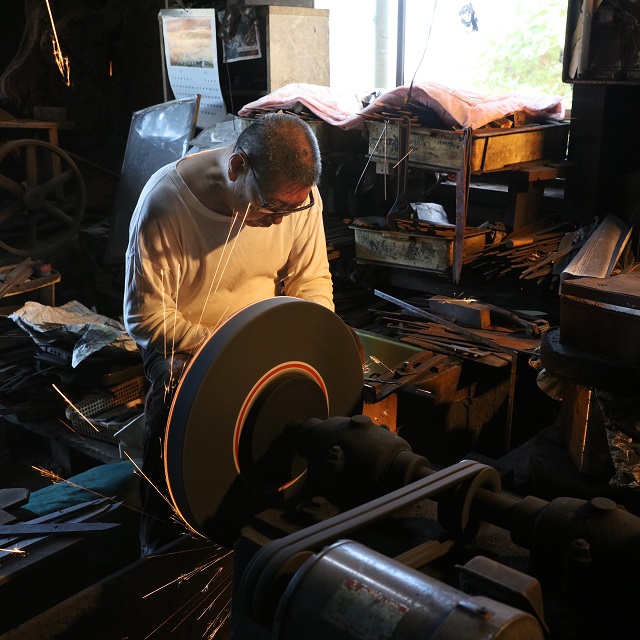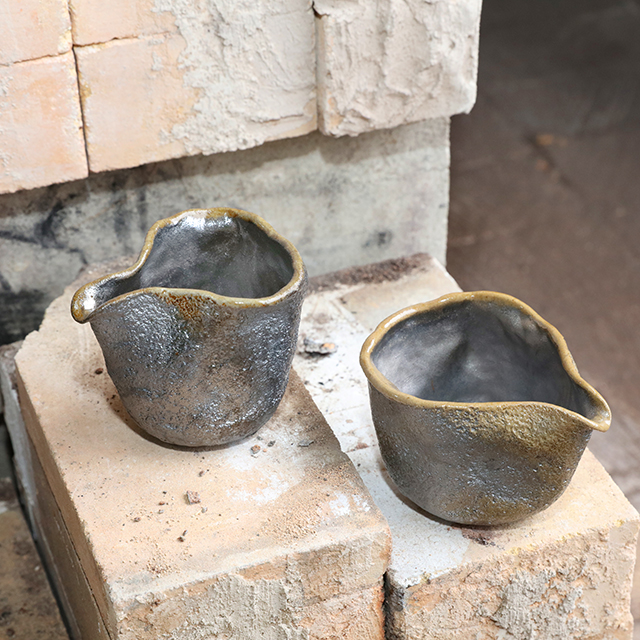Vessels containing scenes of “Karako” playing that are so adorable they make you unconsciously narrow your eyes.
Vessels in which captivating white porcelain is dyed with indigo scrollwork and greenish red lotus flowers, providing a warm, luxurious feel.
The “Hirado Tosho Gokogama” works of potter “Eriko Fujimoto in Sarayama, Nagasaki, the painting and dying of which is subtle with a somehow gentle presence, leave a warm feeling in the heart.
With “Hirado Tosho Gokogama”, mainly vessels produced by Takefusa Fujimoto on the potter’s wheel are painted and dyed by his wife, Eriko. These are vessels produced through the advanced technical skills and high levels of sensitivity brought by them both.
This is a two-part article on “Hirado Tosho Gokogama”. On this occasion, we shall discuss the attractive nature of the painting and dying work provided by Eriko-san.
Actually, a kind of local mascot for the Hirado Domain!? Karako pictures created as a gift or present from the domain
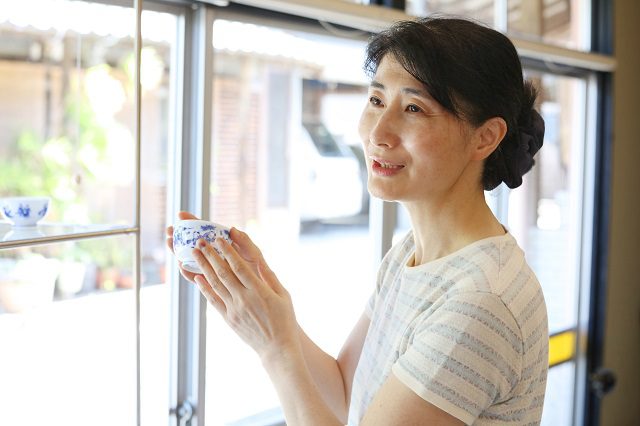
“Hirado Tosho Gokogama” potter Eriko Fujimoto. At the Mikawachi Sarayama exhibition.
In the Edo era, this was used as an official kiln by the clan in Mikawachi Sarayama to make porcelain used as gifts for the Imperial court and shogunate, as well as presents for important visitors from overseas.
Mikawachi porcelain is characterized by white porcelain dyed with a blue dye, known as “Gosu”, and depictions of “Karako” children, with Chinese-style clothes and hair styles. When looking at the reason why such “Karako” came to be painted, Eriko-san gives a humorous example, explaining that “it is said that this was created due to a lord from the Hirado clan, at that time, instructing an artist the in Kano school to design a pattern that exemplifies ‘This is Hirado’. Notice was given out to other clans not to use this picture. It was like a kind of local mascot that we see today.”
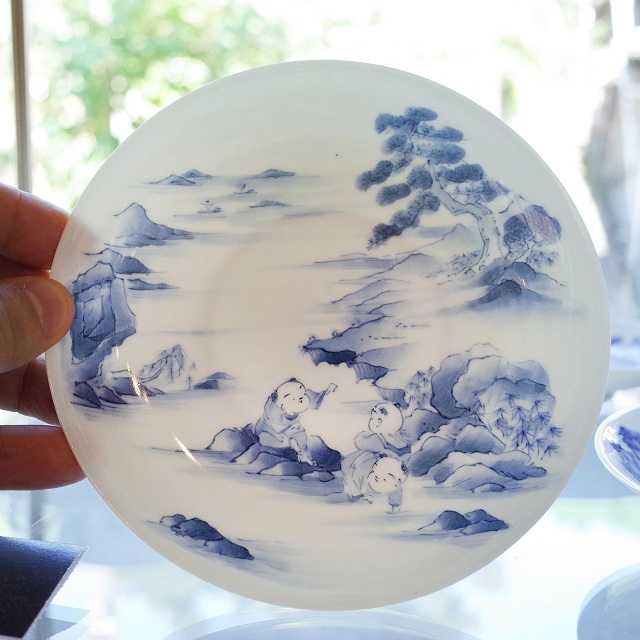
Three “Karako” children playing in the mountain streams.
There is a traditional “present” Karako in which Karako children chase butterflies against a background of peonies in the pine. Those with seven Karako were used as offerings for the Imperial court and shogunate, those with five Karako for nobles and “daimyo”, whereas those with three Karako were to be used by ordinary citizens. “In the beginning there were no restrictions related to the number of people, but at some point, people started to talk in this way.”(Eriko-san)
There were colored vessels with the Karako pattern. As colored ones are rare, I asked if this was a new design, and was told that actually this was from the Edo era.
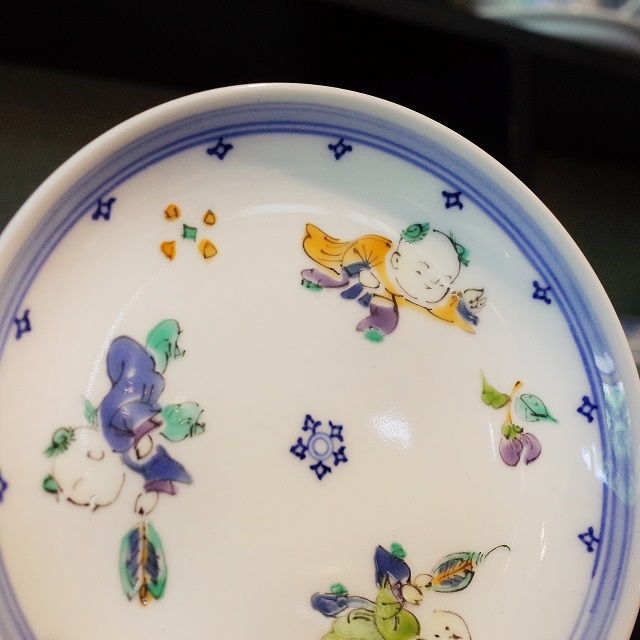
Small plate with colorful “Karako” painting.
“The ones the lords had made for themselves were colored. These can be found in Hirato Castle, Nagasaki Museum of History and Culture, and the warehouses/headquarters of Sasebo City. As the painting materials were expensive, there was a notice telling them not to make colored items when thrift orders were released. During this age, the lords of the Hirado Domain had colored items made for their own use.
Offerings to the shogunate also included colored items, and there are anecdotes claiming that when they were reprimanded, they were able to talk themselves out of the situation by saying ‘We are not using red’. Red was the most expensive color. It was not easy with some of the lords” (Eriko-san).
Karako are like fairies. These are new Karako designed by Eriko-san
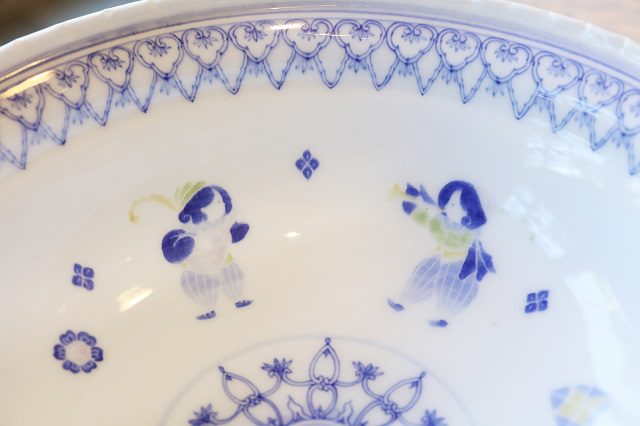
This shows Tensho Boys Mission children as Karako, with colors like stained glass giving it an exotic atmosphere.
There are Karako drifting in an exotic world. There are also depictions of children with musical instruments enjoying performing.
“The Tensho Boys Mission children were made into Karako, and with a design like stained glass, they exude a Dutch atmosphere. It appears that they were excellent students, learning Latin, medicine, as well as musical instruments and dance at the Shimahara Seminary. On returning to Japan, they performed in front of Hideyoshi Taiko using Western instruments, and it is said that, in awe of its excellence, Hideyoshi requested three encores. This was painted while imagining this scene” (Eriko-san) .
There are also Western-style Karako that look like they have jumped out of a picture book. As she has only just started painting these, Eriko-san has said that she is also looking forward to seeing how they will develop.
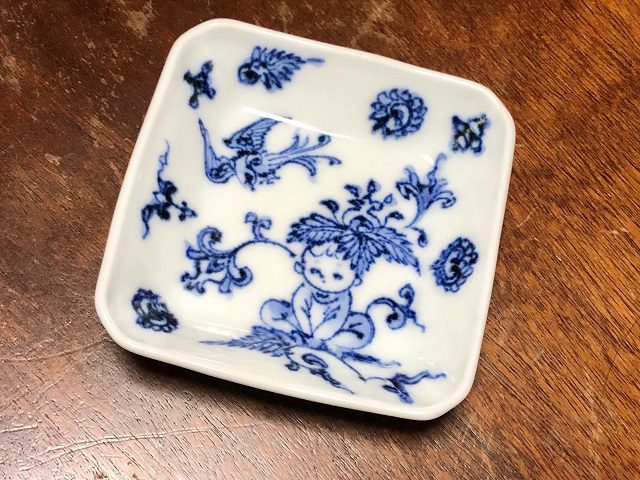
Adorable “Karako” that look they have jumped out of a picture book.
In addition, there are also said to be Karako in loincloths, which were ordered at the time of the “Hakata Dontaku”. There are various other Karako,…such as Karako riding treasure ships, dressed as the seven lucky gods, and Karako that look like “Hina” dolls.
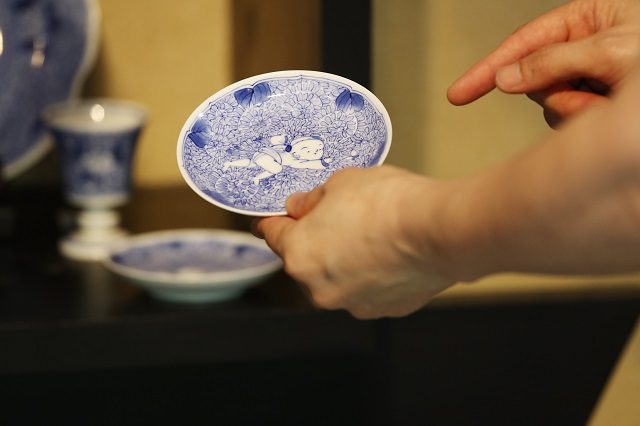
Karako in loincloths made in accordance with “Hakata Dontaku”.
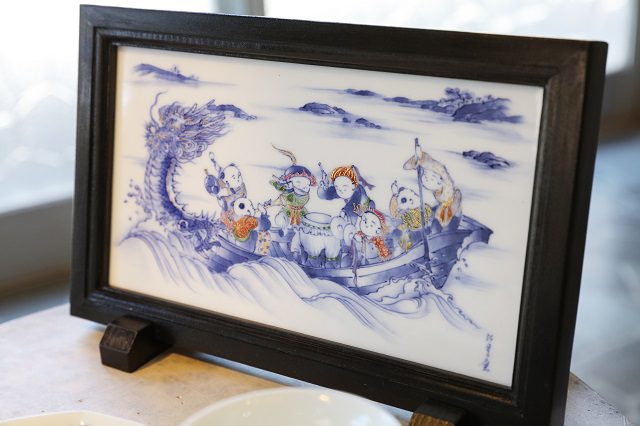
This is a reproduction in Kawachi porcelain of Karako riding a treasure ship, said to have been painted by Katsushika Hokusai.
This was talked about as a lucky charm that brings you good fortune when hung in the entrance to your house.
“When we say Karako, we think of Chinese children, but to me their image is closer to that of fairies than Karako. They are neither boys nor girls, and they don’t have nationality, and as the area where they are is the countryside, if you go the mountain, you might expect to hear an echo like in “Princess Mononoke”. I always think that is what is what I want to express. From now, a different Karako idea may appear. I want to make Karako my life’s work”(Eriko-san).
The greenish red “Seika Yuriko” vessels that give you a warm feeling inside
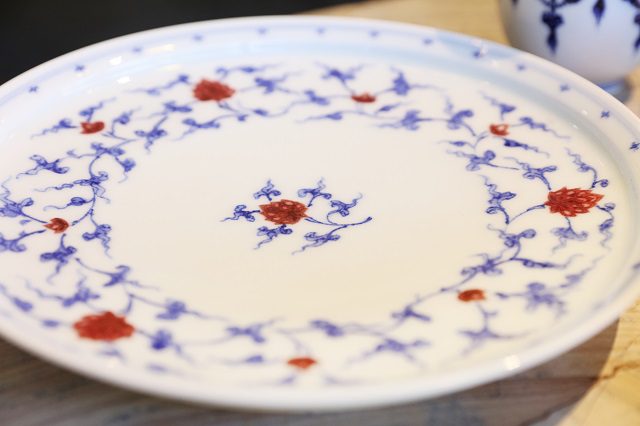
Seika Yuriko made with Mikawa porcelain techniques. You get a feeling of warmth known as “Onjun” (wetness).
This is a vessel dyed with indigo scrollwork and greenish-red lotus flowers on white porcelain. This is applied using the technique known as “Seika Yuriko”. In Arita porcelain, it is overglazed with red and the picture is applied to the fired item. In contrast to this, the red in “Seika Yuriko” is dyed before firing, and by applying glaze and firing it, a chemical transformation takes place, producing the red. This becomes the prized greenish-red known as “Tokakko”. This is matched with the Indigo called “Aobana”
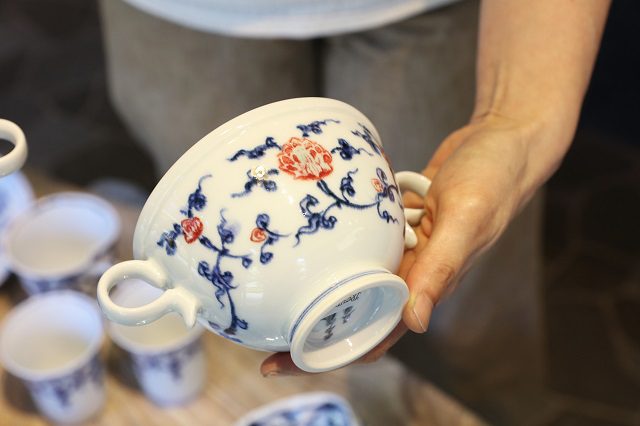
This is a soup mug made with the “Seika Yuriko” technique. Makes a gentle, reddish-green impression.
“Clear red is also good, but I am particularly keen on this kind of fluffy red. It has warmth, and I would recommend it for cold region”(Eriko-san).
As it is a difficult technique, I am not sure that many people would like to take on the challenge of it.
“In Japan, it is said that “Yuuriko” started from the Meiji period, but unfortunately, it is said that it did not go well. It is difficult to produce the colors. There are the three ways of firing porcelain known as oxidizing flame, neutral flame, and reducing flame, and “Aobana Yuuriko” produces red by firing using reducing flame.
If you fire using oxidizing flame, this produces ivory. If you fail, it becomes green rather than red, so it is very difficult to color it with red and blue at the same time”, states Takefusa.
Gold-painted porcelain in the Mikawachi style, using Western painting tools
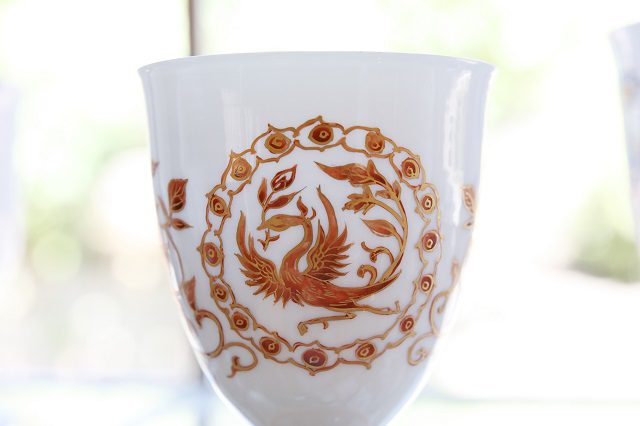
“Rangakude” cups colored using the method known as gold-painted porcelain.
There is “Kinrante” (gold-painted porcelain) where colors are applied through gold glazing over red painting. As this is a design that is loved overseas, items have been exported from Arita, Kutani, Satsuma and Kyoto since a long time ago.
A characteristic of Mikawachi is that it uses western painting tools. This is the same technique as Meissen. The surface does not overflow as much as when painting when using Japanese-style tools, as is seen in Arita and Kutani. It is also a characteristic of Mikawachi that it uses pink and blue. Recently, they have used other materials to produce pink, but in the past, pink could only be produced by gold so it was both precious and high-priced.
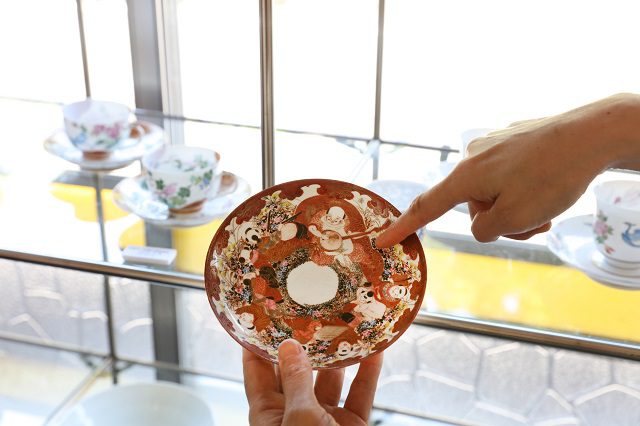
A “Kinrante” plate using Kawachi porcelain remaining in “Hirado Tosho Gokogama”.
This started in the beginning of Meiji, and the study of this was passed on for the Philadelphia Expo in 1876,
“In a certain VIP room, I caught a glance of a “Kinrante” in which a Mikawachi painter had painted over an Arita porcelain base. Probably Mikawachi has been good at such patterns since long ago.
Although the technique in which gold is applied over red is found throughout the country, as there is nobody painting this in Kawachi, we are depicting these by looking at past works. We concentrate on adding plants and flowers, with several black points. This gives it a certain order.
What I am painting now is something that is somewhat of an imitation of what was done in the past, I am hoping that in future I will be able to arrange this in more of a Kawachi style.”(Eriko-san)
Carefully so not to crack it. Dying on a “Rangakude” vessel barely 1mm thick.
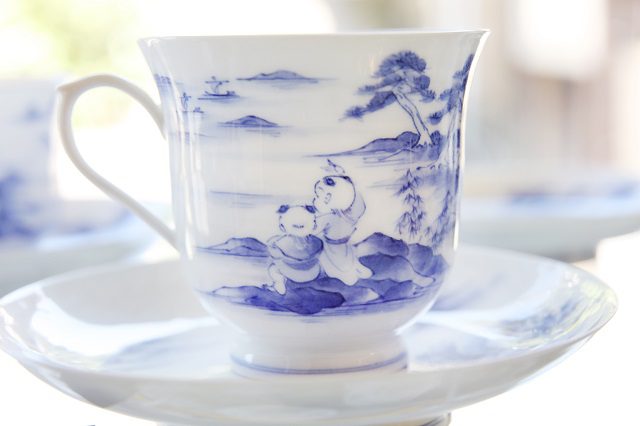
“Rangakude” Sea Karako Picture Coffee Saucer
The “Rangakude sea Karako picture coffee saucer” in the style of “Hirado Tosho Gokogama” was presented as a gift to the King and Queen of Sweden. In “Rangakude”, the pattern is so thin that it looks transparent, and the porcelain is as thin as an eggshell. This technique was temporarily lost, but this was recovered in “Hirado Tosho Gokogama”.
“We heard that the Queen of Sweden liked porcelain, and so the Governor of Nagasaki wanted to present her with “Rangakude” from Nagasaki Prefecture. What I painted at that time was the “sea Karako”, in which seven Karako children were playing by the sea. Sweden is known for the Ria shoreline, and Nagasaki is also a sea town” (Eriko-san).
Applying dyes to “Rangakude” is really difficult. The picture is applied after firing, but it is necessary to apply the colored patterns before firing. Before applying glaze, this is a thickness of 1/3 of the finish. We were allowed to break any “Rangakude” that failed, and we were amazed at how easily they broke, just like eggshells.
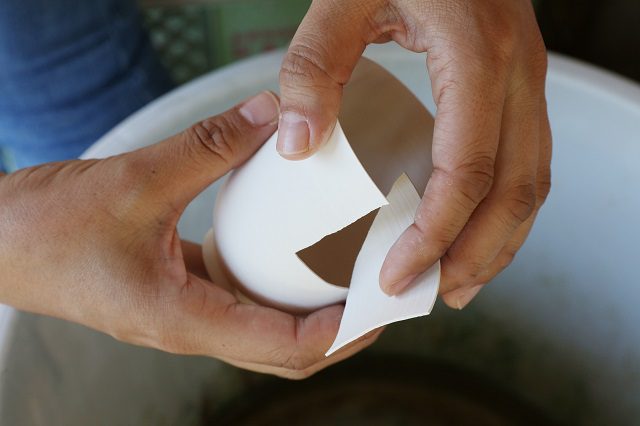
Rangakude base. These are like egg shells. They break at the exertion of even a small amount of force.
“I feel really nervous when I am dying “Rangakude”. They have spent so much time and effort on creating the base. If it cracks when we apply the picture, then all that effort will be to waste”(Eriko-san)
In “Hirado Tosho Gokogama” , a new form of Mikawachi porcelain has been created while learning from the history of porcelain, not only in Mikawachi, but also in Japan and throughout the world, and looking at the past. We were amazed at both the level of technology and their inquiring minds.
More striking than anything else was the gentle smile of Eriko-san as she discussed the Karako. When hearing such discussion, we had the same warm feelings in our hearts as when looking at the works themselves.
Interview cooperated with Hirado Tosho Gokogama
photo by sakurado(Takahiro Suwa)







